Kissing bugs and Chagas disease. By Wizzie Brown, Extension Program Specialist III
Triatomine bugs, also known as kissing bugs, reduviid bugs and cone-nose bugs, are almost an inch long with elongated cone-shaped heads. The body is grayish-brown with a wide abdomen that has flattened sides. The flattened sides of the abdomen stick out beyond the wing margins and are marked with red, orange or yellow stripes. Nymphs (immatures) look similar to adults, but lack fully developed wings.
There are other insects in Texas that look similar and can be mistaken for kissing bugs. Many of these insects do NOT bite and do NOT transmit disease organisms. You can find some common insects that are mistaken for kissing bugs here.
Adults are capable of flying and are attracted to lights at night. The insects can be drawn towards the house by leaving outside lights on at night. Once inside, they will find a host and feed at night. After engorging themselves, they move away from the host to hide in cracks and crevices during the day. Outside, the bugs can be found in
animal bedding or nests such as doghouses, chicken coops or rodent nests.
Some Triatomine bugs carry the parasite Trypanosoma cruzi which can cause Chagas disease in humans, dogs and other small mammals. T. cruzi, a protozoan, is transmitted via the insect’s feces when it is scratched into a wound or rubbed into a mucous membrane. Immediate (acute) symptoms of Chagas may be swelling of the face (especially the area around the eye), swelling of other areas of the body, moderate to high fever, but sometimes acute symptoms never occur. Treatment is available during the acute phase, so see a physician as soon as possible if you suspect Chagas.
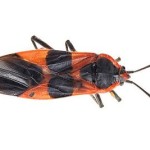
This large milkweed bug is often confused for the kissing bug. Image courtesy of Pat Porter, AgriLIfe Extension
To reduce the chance of Triatomine bugs entering the home, work on excluding them. Some of the following may help to seal the home to keep the bugs outside.
- Prune trees and shrubs so they do not touch or overhang the house
- Do not stack firewood or other items against the house
- Install weather stripping around loose fitting doors and windows- if you can see daylight around a door during the day, then the weather stripping should be replaced
- Block weep holes in brick or stone façade homes with copper mesh
- Use stainless steel mesh wire to block access points in the attic (i.e. vents)
- Sealing holes and cracks leading to the attic, crawl spaces below the house, and to the outside
- Keep window screens in good repair
- Turn off outside lights at night. If that is not possible, use “bug bulbs” or try LED bulbs that have a wavelength less attractive to insects
- Have pets sleep indoors, especially at night, away from areas where insects can gather.
- Keeping your house and any outdoor pet resting areas clean, in addition to periodically checking both areas for the presence of bugs
You can find more detailed information on kissing bugs, Chagas, and where to submit samples on this TAMU website.
Also, media outlets in Dallas recently ran a story on Kissing bugs and Chagas. You can find footage of that here.
More information about triatomine bugs, including bugs that are often mistaken for triatomine bugs and maps of the distribution of U.S. triatomine bugs as of 2011, can be found at http://www.cdc.gov/parasites/chagas/gen_info/vectors/.
More information about Chagas disease can be found at http://www.cdc.gov/parasites/chagas/index.html.
There’s more to picking a good grass than just green: AgriLife Extension turfgrass trials match purpose to environment By: Kay Ledbetter, AgriLife Extension
Not every grass is a good fit for home lawns, golf courses or athletic playing fields, so turfgrass researcher Dr. Casey Reynolds is testing varieties and comparing them side by side under Texas conditions as a part of the National Turfgrass Evaluation Program.
Reynolds, a Texas A&M AgriLife Extension Service turfgrass specialist in College Station, is joined by Dr. Matt Elmore, an AgriLife Extension turfgrass specialist who is growing additional trials at the Texas A&M AgriLife Research and Extension Center at Dallas.
“The primary objective of these NTEP trials is to evaluate new and emerging varieties for their performance in southern and southeastern transition zone environments,” he said. “So, what that means is we plant grasses such as zoysiagrass, Bermuda grass, seashore paspalum and St. Augustine, because we know these species persist and do well in the southern United States and we evaluate them on an equal level.”
Reynolds said the AgriLife Extension trials at both locations include approximately 100 grass varieties, and the College Station trials were recently featured at the Texas A&M AgriLife Turfgrass and Landscape Field Day.
“We’ll take, for example, the NTEP zoysiagrass trial comprised of 30 or so different varieties and compare them to each other based on quality, color, leaf texture, density, drought hardiness, performance and pest incidence,” he said.
The National Turfgrass Evaluation Program then takes that data from this location and data from throughout the U.S. at other cooperating universities and compiles it.
“This way a producer or a customer or anyone who is interested in planting a new variety can look and see an independent source of data and use it to evaluate whether or not that grass is a good fit for their needs,” Reynolds said.
“For instance, we may have a zoysia grass that may do great in terms of how it performs under drought, and next to it one that may look a little better, but the data tells us it may not perform as well under drought,” he said.
NTEP is a great way to organize all that data and compare varieties.
That’s an important thing to understand when selecting a grass variety, Reynolds said, “because we all know in the southern United States drought is always an issue and will continue to be an issue. We certainly want to breed and select grasses that do well in hot, dry climates.
During the turfgrass field day, Reynolds asked the clients attending to place a flag in the plots that they thought looked the best.
“It was interesting to see that a lot of the flags were placed in the same plots,” he said. “I personally like a grass that has dark color, that has
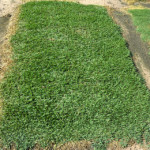
Textured zoysiagrass an alternative to Bermuda and St. Augustine Image by Kay Ledbetter, AgriLife Extension
finer leaf texture and that has good density.”
Reynolds stood near two plots of grass with a big difference in texture, one rated four on texture and the other an eight. Looking at the data, he said, the eight is going to be a much nicer grass, “especially if you are on a golf course tee box, where texture is probably a bigger deal than if you are on a home lawn.
“But if you are a landscaper comparing the two species and you look at the drought data, you might say, ‘I don’t care how fine the texture is if I can’t keep it alive, texture doesn’t matter.’ So your selection may change.”
Reynolds said it is important not to get hung up on having the latest new variety – sometimes if it is not broke, why try to fix it?
“With the data we collect, we try to do it in a manner that is going to be reflective upon how people are going to view these grasses when they get to their home or their golf course or athletic field and whether it is going to fit into their environmental conditions.”
Results of the NTEP trials at College Station and Dallas can be found at http://www.ntep.org/. Other information on turfgrass species and variety selection for Texas can be found at https://aggieturf.tamu.edu/texas-turfgrasses.
Expect invaders as weather gets colder By Paul Schattenberg, AgriLife Extension
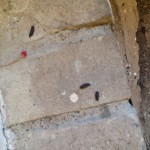
Signs of active rats or mice, is the accumulation of droppings, if you see them, you know it’s time to trap for them.
With temperatures dropping, many Texas residents likely will be getting some unwanted guests in their homes around the holidays, according to Texas A&M AgriLife Extension Service pest management experts.
“This time of year, squirrels, as well as racoons, will try to make nests in attics,” said Janet Hurley, AgriLife Extension program specialist in integrated pest management, Dallas. “Also several species of ants will nest in the walls of homes for warmth and protection.”
Hurley said another unwelcome guest people can expect to see more of as the weather turns colder is mice.
“Rodents can infest homes, threaten public health and destroy property,” Hurley said.
She said the common house mouse, for example, can eat or contaminate household foods, cause structural damage by building nests and gnawing on furniture and electrical wires, and can spread disease.
Hurley said exclusion is an effective means of reducing the threat of rodent-borne diseases, allergens and other health threats. To help exclude mice and other rodents
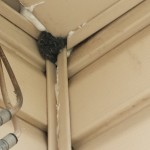
Sealing up openings larger than a dime are important to keep all types of crawling pests out. Ants, cockroaches, mice, rats, squirrels and even birds can be sealed out. Image by Janet Hurley, AgriLIfe Extension
from the home, she recommended:
- Seal gaps of 1⁄4 inch or more with steel wool or a foam sealant that expands. Fill large holes or cracks with concrete or stuff with an excluder cloth and seal them.
- Seal around water, gas, electrical and other pipes and conduits.
- Install brush-type or baffle-style door sweeps to seal exterior doors.
- Seal gaps around eaves and the frames of screens and louvers.
- Do not let trash, weeds or wood accumulate near or along exterior walls or doorways.
- Keep garbage cans covered and lids tightly closed.
- Store pet food off the floor and in airtight containers.
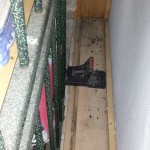 To control mice that have already entered the homes, schools or businesses, Hurley suggests using traps as opposed to poison baits. Snap traps and some of the new
To control mice that have already entered the homes, schools or businesses, Hurley suggests using traps as opposed to poison baits. Snap traps and some of the new
enclosed snap traps will capture the mice and keep them in one spot for easier disposal.
“If there are young children or pets in the home, consider placing the traps inside locked box stations to avoid accidents,” Hurley said. “The use of poison baits should be a last resort and is best left to the professionals since there could be risk to children and pets.”
Anyone traveling during the holidays should be aware of the potential for picking up bed bugs, according to Dr. Mike Merchant, AgriLife Extension urban entomologist for Texas A&M AgriLife Extension. Bed bugs are small, reddish-brown, oval-shaped insects that feed on human blood and are becoming more common in hotels and homes.
“Bed bugs are great at hitchhiking in luggage, and savvy travelers should know how to minimize their risk of bringing an unwelcome guest home from the holidays,” Merchant said.
He noted that while the risk of encountering these pests in your travels is relatively low, bringing a bed bug home is definitely not a good idea.
“Suffering a few bed bug bites while travelling is not pleasant, but it’s much worse to bring them home where they can proliferate,” he said.
Experts recommend avoiding setting luggage on or next to a bed or other upholstered furniture where bed bugs can easily stow away after feeding.
“This practice is an open invitation for bed bugs,” he said. “Instead, put your stuff on the luggage rack away from the bed.”
“It’s just now starting to get close to freezing in the South Central Texas area, but in the next few weeks I expect to start getting calls about more insects coming indoors,” said Wizzie Brown, AgriLife Extension entomologist for Travis County. “The ones I’m most likely to be getting calls about will be cockroaches, spiders and scorpions.”
Brown said the most effective means of control is to exclude these and other critters from the home by way of sealing exterior holes or cracks as well as eaves and frames around doors and windows.

Keeping trees and shrubs from touching the house, or hanging over help keep pests away. Image by Janet Hurley, AgriLIfe Extension
“And if you have any tall grass or weeds around your house, or any wood, compost or leaves near your exterior walls, now would be a good time to remove those so they don’t provide a warm nesting area from which they might then enter your home,” she said.
Brown said now might also be a good time to prune any trees or shrubs that touch or overhang the house.
“That way animals can’t use those as a bridge to enter the house,” she said.
For more information on insect identification, exclusion and control, go to visit our homeowner websites http://communityipm.tamu.edu/ or national website.
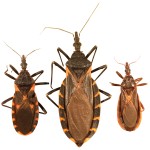
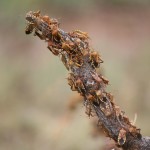
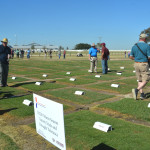
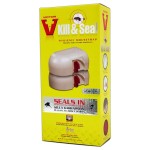


 .
.